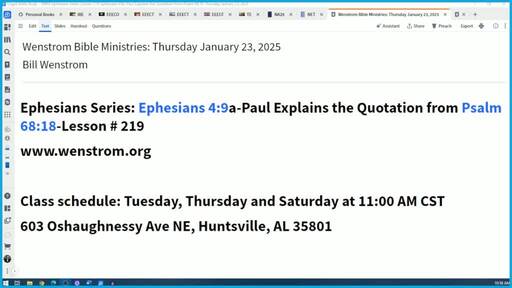Ephesians 4.9a-Paul Explains the Quotation from Psalm 68.18
Wenstrom Bible Ministries
Pastor-Teacher Bill Wenstrom
Thursday January 23, 2025
Ephesians Series: Ephesians 4:9a-Paul Explains the Quotation from Psalm 68:18
Lesson # 219
Ephesians 4:7 Now, however, to each one of us grace was given corresponding to the incomparable Christ’s proportionate gracious giving. 8 Therefore, it says, “When he ascended to the highest place, he captured captives. He generously gave gifts to certain members of the human race.” 9 In other words, what is the meaning of the statement, “he ascended?” Namely that, he also descended into the lower regions, which are part of the earth? (Lecturer’s translation)
Ephesians 4:9 is composed of the following:
(1) rhetorical question: to anebē ti estin (τὸ ἀνέβη τί ἐστιν), “what is the meaning of the statement, ‘he ascended?’” (Author’s translation)
(2) appositional clause: ei mē hoti kai katebē eis ta katōtera merē tēs gēs (εἰ μὴ ὅτι καὶ κατέβη εἰς τὰ κατώτερα μέρη τῆς γῆς), “Namely that, he also descended into the lower regions, which are part of the earth?” (Author’s translation)
This rhetorical question and appositional clause serve to explain the previous quotation from Psalm 68:18, which Paul uses in Ephesians 4:8 to support his assertion in Ephesians 4:7.
In fact, not only does Paul explain this quotation in Ephesians 4:9 but he also does so in Ephesians 4:10.
He is not simply explaining what Christ’s ascension means but the entire quotation is being explained.
The interrogative pronoun tis (τις), “what” introduces a rhetorical question, which Paul then in turn explains in the rest of the verse and in Ephesians 4;10.
The referent of this interrogative pronoun is identified by the rest of the verse, namely, ei mē hoti kai katebē eis ta katōtera merē tēs gēs (εἰ μὴ ὅτι καὶ κατέβη εἰς τὰ κατώτερα μέρη τῆς γῆς), “except that he also descended to the lower regions, namely, the earth?” (NET)
The verb anabainō (ἀναβαίνω) here in Ephesians 4:9 and as was the case in Ephesians 4:8 refers to the act of Jesus Christ ascending to the right hand of His heavenly Father forty days after His resurrection.
The third person singular present active indicative conjugation of the verb eimi (εἰμί) means “to be equivalent to, to be identical to” since the word pertains to showing how something is to be understood.
In context, it pertains to expressing or conveying or explaining the meaning of Psalm 68:18, which Paul quotes in Ephesians 4:8.
Therefore, this would indicate that Jesus Christ descending to the lower parts of the earth as the subject performs the action of explaining the quotation from Psalm 68:18, which we noted Paul uses in Ephesians 4:8 to support his assertion in Ephesians 4:7.
The interrogative pronoun tis (τις) functions here as the nominative subject, which would indicate that Jesus Christ descending to the lower parts of the earth as the subject performs the action of explaining the quotation from Psalm 68:18, which we noted Paul uses in Ephesians 4:8 to support his assertion in Ephesians 4:7.
The predicate nominative is the third person singular aorist active indicative conjugation of the verb anabainō (ἀναβαίνω), which would indicate that this word is making an assertion about the subject.
This would indicate that Jesus Christ’s ascension is making an assertion about the subject, which is His descending to the lower regions of the earth.
Specifically, the assertion is that Jesus Christ’s ascension is explained as His descending to the lower parts of the earth.
The conditional particle ei (εἰ) and the negative particle me (μή) coalesce into one particle and together they function as an explanatory marker meaning the word is introducing an assertion which answers the previous rhetorical question and defines or explains the meaning of Jesus Christ’s ascension to the right hand of the Father.
The conjunction hoti (ὅτι), “that” is employed with the indicative mood of the verb katabainō (καταβαίνω), “he descended” in order to form an appositional clause, which means that it stands in apposition to the interrogative pronoun tis (τις), and identifies the referent of the latter.
The conjunction kai (καί) “also” is adjunctive meaning that the word introduces the verb katabainō (καταβαίνω), “he descended,” which serves as an addition to the verb anabainō (ἀναβαίνω), “he ascended” and helps to define the meaning or explain the meaning of the latter.
Jesus Christ first had to descend to the lower regions of the earth before He ascended to the right hand of His heavenly Father because before He could give gifts to those who trust in Him as Savior, He first had to redeem these individuals and reconcile them to His Father who is holy by propitiating the Father’s holiness, which demanded that sin and sinners experience His wrath in the eternal lake of fire.
The verb katabainō (καταβαίνω) expresses the idea of Jesus Christ “descending” into the lower regions of the earth.
The adjective katōteros (κατώτερος), “the lower” pertains to being in a position below a point of orientation.
In context, it speaks of a position lower than the surface of the earth and thus underneath the earth’s surface.
The noun meros (μέρος), “regions” refers to the regions underneath the surface of the earth and the noun gē (γῆ), “the earth” pertains to the place where human beings and animals live and in the modern sense is the third planet from the sun.
The articular construction of this word is generic meaning it is distinguishing planet earth from the three levels of heaven, which are the earth’s atmosphere, the stellar universe and the throne room of God.
The noun gē (γῆ) is interpretated by some expositors as functioning as a genitive of apposition or an epexegetical genitive, which takes place when the substantive in the genitive case refers to the same thing as the substantive to which it is related.
The genitive of apposition typically states a specific example that is a part of the larger category named by the head noun.
It is frequently used when the head noun is ambiguous or metaphorical (hence the name “epexegetical genitive” is quite appropriate).
This interpretation of the genitive case of the gē (γῆ) would express the idea that Jesus Christ descended “into the lower parts, namely, the earth.”
The NET Bible has the following note on this interpretation, they write “Many recent scholars hold this view and argue that it is a reference to the incarnation.”
They also state another interpretation of the genitive form of this noun is that it refers to the descent of Jesus Christ occurring “after” His ascent rather than before it, and refers to the descent of the Spirit at Pentecost (cf. Acts 4:11–16). Support for this latter view is found in the intertestamental and rabbinic use of Ps 68:18 (quoted in v. 8), which is consistently and solely interpreted as a reference to Moses’ ascent of Mt. Sinai to “capture” the words of the law. The probability, therefore, is that the comments here in v. 9 reflect a polemic against the interpretation of Ps 68:18 in certain circles as a reference to Moses. See W. H. Harris, The Descent of Christ (AGJU 32), 46-54; 171–204
However, I interpret the noun gē (γῆ) as functioning as a partitive genitive, which takes place when the substantive in the genitive denotes the whole of which the head noun is a part.
In this present context, the head noun is meros (μέρος), “regions,” which is modified by the adjective katōteros (κατώτερος), “the lower.”
Therefore, this indicates the noun gē (γῆ) denotes the whole of which the head noun is meros (μέρος) is a part.
Thus, this construction indicates that the lower regions are part of planet earth.
The NET Bible writes that “the traditional view understands it as a reference to the underworld (hell), where Jesus is thought to have descended in the three days between his death and resurrection.”
The noun meros (μέρος) is the object of the preposition eis (εἰς), which is marking the area into which Jesus Christ descended after physically dying on the cross indicating that He descended “into” the lower regions, which are a part of the earth.
I interpret the expression eis ta katōtera merē tēs gēs (εἰς τὰ κατώτερα [μέρη] τῆς γῆς), “into the lower regions, which are part of the earth” as referring to Jesus Christ’s descent into Hades after His physical death on the cross and before His resurrection.
Hades or Sheol contains four compartments:
(1) Paradise: the place of the departed souls of believers before the resurrection of Christ (Lk. 23:39-43; Eph. 4:8-9) who were transferred to heaven after the resurrection and ascension of Christ (Eph. 4:10).
(2) Torments: the temporary fire for the souls of unbelievers from all dispensations (Lk. 16:19-31) who will be transferred to the Great White Throne Judgment that concludes human history and from there will be cast in the Lake of Fire forever (Rev. 20:11-15).
(3) Tartarus: the abode of the fallen angels of Genesis 6 who possessed unregenerate men during the antediluvian period in order to have sex with unregenerate women in order to corrupt the character of the human race and thus prompt God to judge the human race and consequently prevent the incarnation of the Son of God (1 Peter 3:18-22; 2 Peter 4; Jude 6).
(4) The Abyss: the place of imprisonment for the demons who violated certain rules for angelic creation and will be released during the Tribulation (Lk. 8:30-31; Rom. 10:7; Rev. 20:1-3).
Prior to the resurrection, ascension and session of the Lord Jesus Christ, Old Testament saints when they died did not go to the third heaven but rather to Paradise.
These Old Testament saints such as Abraham ascended with Jesus Christ into heaven as part of our Lord’s triumphal procession as victor in the angelic conflict and were part of the booty from our Lord’s victory that was accomplished through His death and resurrection.





